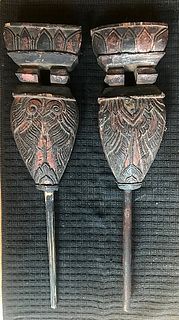Guanyin sitting. China, 20th century. Coral.
Lot 106
About Seller
Setdart Auction House
Carrer Aragó 346
Barcelona
Spain
Setdart Subastas was born in 2004 and is currently the first online art auction in Spain with solidity, prestige and reliability guaranteed by our more than 60,000 users. Setdart has a young, dynamic and enterprising team ready to successfully manage the purchase and sale of art works through custom...Read more
Categories
Estimate:
EUR€3,500 - EUR€4,000
$3,645.83 - $4,166.67
Absentee vs Live bid
Two ways to bid:
- Leave a max absentee bid and the platform will bid on your behalf up to your maximum bid during the live auction.
- Bid live during the auction and your bids will be submitted real-time to the auctioneer.
Bid Increments
| Price | Bid Increment |
|---|---|
| EUR€0 | EUR€10 |
| EUR€200 | EUR€25 |
| EUR€500 | EUR€50 |
| EUR€1,000 | EUR€100 |
| EUR€3,000 | EUR€200 |
| EUR€5,000 | EUR€500 |
| EUR€10,000 | EUR€1,000 |
| EUR€20,000 | EUR€2,000 |
| EUR€50,000 | EUR€5,000 |
About Auction
By Setdart Auction House
Jun 16, 2021
Set Reminder
2021-06-16 06:15:00
2021-06-16 06:15:00
America/New_York
Bidsquare
Bidsquare : Oriental Art Collection
https://www.bidsquare.com/auctions/setdart-auction-house/oriental-art-collection-7080
Setdart Auction House sofia@setdart.com
Setdart Auction House sofia@setdart.com
- Lot Description
Guanyin sitting. China, 20th century. Coral. Weight: 850 gr. Measurements: 16.5 x 7 x 4 cm (without base); 22.5 x 13 x 10 cm (with base). Figure entirely made of carved coral representing Guanyin. Also known as bodhisattva of compassion, Guanyin is venerated by East Asian Buddhists. As a result of syncretism, it is commonly accepted that her figure is the female counterpart of Avalokitesvara, Hindu bodhisattva of compassion. The first Buddhist monk who referred to Guanyin in feminine form was Kumarajiva, when translating the Lotus Sutra into Chinese in 406 AD. With the introduction of Vajrayana Buddhism in China during the Tang dynasty, in the 8th century, the representation of Avalokitesvara as a beautiful female figure dressed in white grew in popularity. In popular devotion, Guanyin rescues those who turn to her in times of difficulty, especially in the face of dangers produced by water, fire or weapons. As a Merciful Mother, she also responds to the requests of those who wish to have children, which is why she is usually represented accompanied by a child. The iconography of Guanyin is rich and varied, and includes various symbolic elements alluding to different concepts. Among the most beautiful products that the sea offers to the vanity of humans is, without a doubt, red coral, which in all times has served as a precious adornment with which many peoples adorned and ornamented themselves. In some Eastern cultures, red coral is not only a highly esteemed adornment, but also a sign of dignity or command: the mandarins of China wore it as an attribute of their authority. The Turks were also very fond of coral ornaments, which they wore not only on their person, but also in the decoration and ornamentation of their homes. The Greeks designated coral by the name of korallion, which means "ornament of the sea", this word passed into Latin as corallium, from which the word coral was derived. The color of the limestone shaft offers a great variety of shades ranging from red to pink and some of these colorations have a delicate and soft pink hue, the most sought after by divers. The limestone shaft is so compact and homogeneous that it can be subjected to the most perfect polishing without disintegration and cracking, a property that allows it to be worked and carved in a thousand different ways to achieve an infinite number of decorative or artistic objects.
- Shipping Info
-
In-house shipping available. Please inquire at admin@setdart.com.
-
- Buyer's Premium



 EUR
EUR CAD
CAD AUD
AUD GBP
GBP MXN
MXN HKD
HKD CNY
CNY MYR
MYR SEK
SEK SGD
SGD CHF
CHF THB
THB













